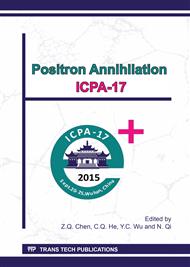p.179
p.183
p.189
p.193
p.197
p.201
p.205
p.209
p.213
Effect of TiO2 Doping on Microdefects and Electrical Properties of ZnO-Based Varistors
Abstract:
Positron lifetime spectrum and electrical property measurements were performed on ZnO-based ceramics doped with different contents of TiO2. For ZnO-based ceramics with TiO2 content less than 1.8 mol%, the mean positron lifetime of the ZnO-based ceramic decreases with increasing in TiO2 content, and reaches a minimum value at 1.8 mol% TiO2. As the TiO2 content higher than 1.8 mol%, the mean positron lifetime increases with TiO2 content. The ZnO-based varistor with 1.8 mol% TiO2 exhibites an optimized varistor property; it has a relatively low leakage current IL, a relatively low breakdown voltage VB, and a relatively high nonlinear coefficient α. The effects of TiO2 doping on microdefects and electrical properties of ZnO-based varistors were discussed.
Info:
Periodical:
Pages:
197-200
Citation:
Online since:
March 2017
Authors:
Keywords:
Price:
Сopyright:
© 2016 Trans Tech Publications Ltd. All Rights Reserved
Share:
Citation:


